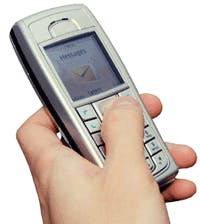Move: Avoid the Dangers of Distracted Drivers
Keeping a supply chain connected to the road ensures that all interested parties stay informed of costly delays, unscheduled pick-ups and cargo changes in real-time. This requires reliable communications.
However, the communications landscape is changing fast and reliability has been affected by regulations. With the U.S. Department of Transportation (DOT) restricting the use of handheld mobile telephones by drivers of commercial vehicles, and with Nextel decommissioning its iDEN network, the modes of communications carriers have grown to rely on may suddenly disappear. As a result, keeping transportation fleets connected has become a more challenging proposition. It requires a thorough transition strategy.
The Dangers of Distracted Driving
In 2010, more than 3,000 people were killed in distracted driving crashes and an estimated 416,000 were injured, according to the DOT (www.distraction.gov). Texting and using a cell phone or smartphone top the list of the most serious driving distractions. Texting in particular is considered the most serious offense as it requires visual, manual and cognitive attention of a driver.
The Federal Motor Carrier Safety Administration (FMCSA) banned commercial truck and bus driversThe American Trucking Associations (ATA) has likewise taken the following position on handheld cell phone use:
“ATA supports laws and regulations that ban a driver of any vehicle from holding a wireless communications device to conduct a conversation while driving, but allows the use of hands-free devices that enable the driver to conduct a conversation without holding the device. Such laws and regulations should retain current exemptions which permit drivers to enter a telephone number, an extension number, or voicemail retrieval codes into an electronic device for the purpose of initiating or receiving a phone call or using voice commands to initiate or receive a telephone call. Such laws and regulations should also permit the use of other devices (e.g., CB radios) not otherwise prohibited by law or regulation."
In light of new restrictions, significant change—in both behavior and technology—will be required for many.
The Price of Non-Compliance
Drivers who do not comply with distracted driver regulations will be subject to federal civil penalties of up to $2,750 for each offense. Motor carriers that allow their drivers to use handheld cell phones while operating a commercial motor vehicle face a maximum civil penalty of $11,000 per violation. FMCSA and the Pipeline and Hazardous Materials Safety Administration (PHMSA) believe that both handheld use of mobile telephones and texting are risky behaviors and should have large fines associated with them.
Shippers that have relied on iDEN systems in the past have until June of this year to transition to a new communications system. As decommissioning begins, many drivers are already experiencing communication dead zones as tower sites come down, jeopardizing their safety.
Acceptable Options
Despite new requirements, cost-effective options can allow drivers to work safely and efficiently and retain the convenience of PTT.
Long the communications standard in CMV operations, Citizens Band (CB) radio use is still considered a safe option as it doesn't require drivers to look away from the road while in use. The casual radio conversation about traffic and road conditions is considered essential to many over-the-road drivers. However, with the increasing need for data and more advanced fleet management applications, it is probably the least robust communications solution.
Professional two-way radio can provide both reliable business dispatch connectivity as well as direct communications with other company drivers over a much larger area than CB radios. These systems combine the best of two-way radio functionality with the latest digital technology. They comply with both U.S. DOT and FCC regulations as long as they are not connected to Public Switched Telephone Networks (PSTN). With integrated voice and data, they offer enhanced, easy-to use features and deliver twice the capacity of analog systems. They also provide fleet operations with high tech digital communications for dispatch, vehicle management and driver safety.
These systems improve workforce safety both on the road and off by allowing emergency alerts to drivers or dispatch with a push of a button. Other operator benefits include:
- Vehicle diagnostic updates by utilizing on-board telematics linked through mobile radios to fleet management software at their facilities;
- Hands-free accessories, like operations critical Bluetooth, help keep drivers focused on the road and confirm destination details;
- GPS tracking and dispatch for improved driver/fleet visibility;
- Work order ticket management to track delivery cycle time;
- Easy migration from analog to digital communications with mixed mode functionality.
Mobile devices and smartphones may still be used by CMV drivers, however only in hands-free mode within their “close proximity." Using the device in any other manner is out of compliance, unless the driver is off the road and parked.
What to Do Now
In light of the communications changes ahead, it's important to create a comprehensive transition plan that clearly defines company policies and specifically addresses the federal restrictions and general changes to the communications landscape. Solutions exist to add greater visibility to freight, vehicle telematics and delivery schedules all while helping keep drivers reliably connected and safe.
Ultimately, the responsibility for educating drivers about the new changes to federal regulations—and the fines and penalties associated with them—falls on their employers. But any company that relies on carriers or third parties to handle their shipping should find out how they intend to deal with the new restrictions while ensuring the real-time communications required to help keep operations running smoothly.
The ATA recommends that affected parties review all new rules with legal counsel and/or safety directors and develop language that's appropriate for their company, partners and drivers.
Ralph Lieberthal is principal, Transportation & Logistics, for Motorola Solutions.

